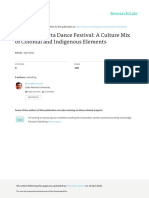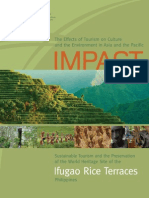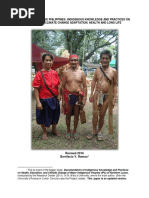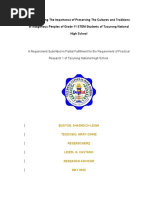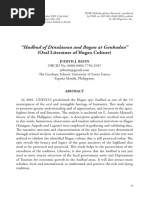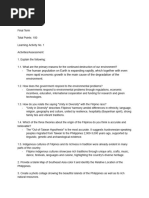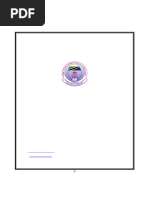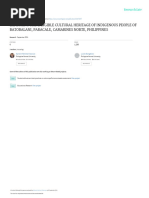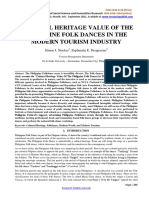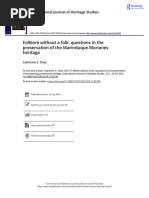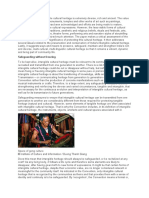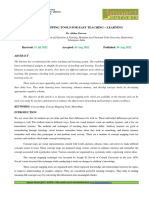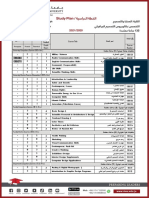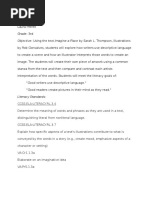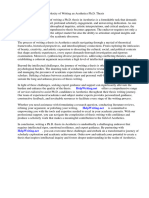Ethnographic Influence Among Manobo Tribesmen in The Philippines
Ethnographic Influence Among Manobo Tribesmen in The Philippines
Uploaded by
Impact JournalsCopyright:
Available Formats
Ethnographic Influence Among Manobo Tribesmen in The Philippines
Ethnographic Influence Among Manobo Tribesmen in The Philippines
Uploaded by
Impact JournalsOriginal Title
Copyright
Available Formats
Share this document
Did you find this document useful?
Is this content inappropriate?
Copyright:
Available Formats
Ethnographic Influence Among Manobo Tribesmen in The Philippines
Ethnographic Influence Among Manobo Tribesmen in The Philippines
Uploaded by
Impact JournalsCopyright:
Available Formats
IMPACT: International Journal of Research in
Engineering & Technology (IMPACT: IJRET)
ISSN (E): 2321-8843; ISSN (P): 2347-4599
Vol. 4, Issue 5, May 2016, 99-102
Impact Journals
ETHNOGRAPHIC INFLUENCE AMONG MANOBO TRIBESMEN IN THE PHILIPPINES
CHARITY G. RONAMO
Faculty, College of Education, Cotabato Foundation College of Science and Technology,
Doroluman Arakan Cotabato, Philippines
ABSTRACT
This study focused on the documentation of the existing sports and socio-cultural related collections in every
home of the Filipino ethnic groups of the selected municipalities in the province of North Cotabato, Philippines.
The collection of photos and the determination of the extent of influence on ethnographic technologies and beliefs and
practices from generation to generation focused only on implements, dance and musical instruments, arts and crafts, rituals
and practices, socialization, sports and socio-cultural activities including courtship and marriage.
KEYWORDS: Ethnography, Collection, Culture, Implements, Protection
INTRODUCTION
The preservation of indigenous culture has become a priority item in the national agenda, and the government has
expectedly made significant interventions in this area of concern. It is in the cultural heritage that a country can be distinct
from one another. Heritage collection is the connecting agent of the past and the present. Without the past, the present will
be unstable and the future has no direction when it comes to culture. One country can be known and become a tourist
destination because of the artifacts and colorful history. It was declared by the Philippine Tourism Authority that
Philippines will soon become a medical tourism capital in Asia as cited by Barcelona (2008). It is because of the distinct
characteristics of the Filipino being so caring and hospitable. It was also noted by many countries where Filipino medical
health providers like nurses, doctors, caregivers and even tour guides are very much effective due to the innate traditions
and practices within the heart of every Filipino. It is then a very great asset for a country to welcome more tourists.
To describe best the nature and culture of one country, collections of artifacts and artworks are considered very
vital in establishing each trademark. The National Commission for Culture and the Arts (NCCA) is entrusted to establish
strong nation through culture caregiving. It was emphasized by Ceceile Gedote-Alvarez (2006) during her talk that all State
Universities and Colleges (SUCs) should act as Care Giver of cultural heritage and arts so that the Philippine treasure will
be saved.
Every tangible evidence of an authentic equipment, implements, tools, artworks, instruments and fossils of the
past is considered treasure of the present and a strong foundation of the future. In many experiences, the Spolarium of Juan
Luna was found in other countries wherein the Philippines had bought it through Government Service Insurance System
(GSIS) amounting to PhP48 Million because it should be returned to its hometown.
Many artifacts are sold in dollars because the owners have other priorities than looking at these things found in
their ancestral homes. Instant incentives are very important to heirs without considering the historical and sentimental
Impact Factor(JCC): 1.9586- This article can be downloaded from www.impactjournals.us
100
Charity G. Ronamo
values of such material collections.
The influence of western and oriental civilization had made Philippine culture unique and distinct yet, in the later
time, had gradually vanished among young generations. The Filipino identity was replaced with Western acculturation.
Thus, traditional practices in farming, wedding celebrations, architecture, interior designing, sports and socio-cultural
festival and competitions were also adulterated.
In the advent of changes and modernization, there are cultures and arts set aside for progress. Likewise,
Mindanaons having a colorful traditions and meaningful history are always the trademark of Mindanao. A lot of festivities
are celebrated like Patronal Fiestas, (OTOP) Festivals and many holidays. These are some cultural tourism strategies of
every municipality to draw popularity and therefore income-generation of all stakeholders from transportation operators,
drivers, vendors, hotel and restaurant owners and merchandisers.
The sector of other cultural discipline aside from cultural dances like visual arts particularly weaving, pottery,
painting, architecture, handicraft and the rituals including the industry of making tools and instruments should also be
preserved and taken care of by every Filipino thus, this study seeks to reach out and be documented through a researchbased results.
OBJECTIVES OF THE STUDY
The objectives of the study were to: (a) determine the sports related collections that are available in the hands of
the contemporary Manobo, (b) determine the socio-cultural related collections that are available in the hands by the
contemporary Manobo, (c) determine the extent of sports and socio-cultural practices influence of Manobo from generation
to generation in terms of implements, dance and musical instruments, arts and crafts, (d) determine the extent of influence
of beliefs and practices in terms of spiritual, social and traditional Sports and socio-cultural Activities, and e) determine the
sports and socio-cultural ethnographic technologies and beliefs and practices that has significant value to the Manobo
community when grouped according to: age, gender and occupation.
RESULTS AND DISCUSSIONS
There were 13 items or collections which can be grouped into sports and socio-cultural related collections like
implements or weapons, musical instruments like gong substitutes, apparel and weaving products and architectural designs
aging from 30-180 years old. The traditional sports and socio-cultural aspects were described as to the greatest influence.
Their ethnographic technologies, beliefs and practices have significant value to the Manobo respondents. A relationship
exists between the age of respondents and the dance and musical instruments and the traditional sports and socio-cultural
traditional beliefs and practices. Both genders have equal weight and do value the ethnographic technologies and beliefs
and practices related to sports and socio-cultural aspects. Cultural bearers come from both male and female thus, anybody
in the community of Manobo can be tapped by the government to influence the tribe so that the ethnic tribes struggle for
cultural identity will be realized.
CONCLUSIONS
Based on the intense results of the study, it is at this moment concluded that Manobo tribes from the selected
municipalities of the Province of Cotabato, Philippines are protecting their ethnographic technologies like tribal
Index Copernicus Value: 3.0 - Articles can be sent to editor@impactjournals.us
Ethnographic Influence among Manobo Tribesmen in the Philippines
101
implements, instruments, arts, and crafts. They ensure that protection, extra care and proper handing down of such treasure
become a responsibility of each of the tribesmen with the belief that these are precious, and a bad luck may happen if they
fail in this regard.
Regardless of gender and occupation of the members of the family, the values of the Manobo ethnographic
treasure in the form of technology and beliefs and practices is very important to be preserved and conserved. However,
dance and musical instruments including the traditional sports and socio-cultural beliefs and practices have significant
value to the Manobo tribes when grouped into age.
REFERENCES
1.
Cario, Jacqueline., November 2012. Country Technical Notes on Indigenous Peoples Issues Republic of the
Philippines.
2.
Bangi, Juliet C., Cabatac, Neyma N., & Agrave, Paulino., Ethnopedology: Indigenous Soil Management Practices
of the Cultural Minorities in Cotabato Philippines.
3.
De Leon, Lydia Mary., Lumad sa Mindanao: Kagahapon, Karon ug Ugma http://litera1no.4tripod.com/manobo
frame.html
4.
Fraiser, Douglas M., Philippine Studies. Land Conflict of the Cotabato Manobo. (Phil. Studies) Vol. 49. No. 12
(2001). http://www.phhilippinestudies.net fri June 27 13;30:20 2008.
5.
Maceda, Marcelino N., Preliminary Report on Ethnographic Archaeological Field Work in the Kulaman Plateau,
Island of Mindanao, Philippines. (Bd. 59. H. (1964). Pp. 75-82. http://www.jstor/stable/40456283
6.
Otanes, Fe T. & Hale, Austin. Studies in Philippine Linguistics Vol. 7 # 1 1988.
7.
Ramos, Arnulfo B., Indigenous Practices of Maternal and Child Health Care Among the Manobo-Matigsalug
Tribe in Sitio Simsimon, Barangay Kalagangan, Valencia, Bukidnon. Vol. 10. No. 1 (2008). ejournals.ph
8.
Shotton, Peter A., Dr. Armour, Kathleen M., &Potrac, Paul., Student Contribution: An Ethnographic Study of
Gender Influences onSocial Behavior of Members at a Private Golf Club. Brunei University, England.
www.iamure.com
9.
HORFILLA, NESTOR., (1996) Arakan: Where Rivers Speak of the Manobos Living Dreams. Matina, Davao
City: Tribal Filipino Program for Community Development, Inc.
10. UOTILA, TUOMO., The Use of Future Oriented Knowledge Transfer in Regional Innovation Processes:
Research on knowledge generation, transfer and conversion. John Wiley & Sons Ltd.
11. VANDELL, D. L., (2003) Establishing Research Standards. Washington DC:
12. VEZZOLI, CARLO., Design and Evaluation for Sports Programs. Milan, Italy: DIS Research Unit.
13. INGLES, ELMAR BELTRAN, 2011. Cultural Education as Imperative to Sustainable Development. Agung.
National Commission for Culture and the Arts, December issue. pp 20-21
14. SUEMITH, ADELINA M. 2011. Getting to the Navel of Life at Sea. Cultural Education as Imperative to
Impact Factor(JCC): 1.9586- This article can be downloaded from www.impactjournals.us
102
Charity G. Ronamo
Sustainable Development, Agung. National Commission for Culture and the Arts, December issue, pp 20-21
Index Copernicus Value: 3.0 - Articles can be sent to editor@impactjournals.us
You might also like
- James Wong HoweDocument450 pagesJames Wong HoweMarco A. Gutiérrez Cordero100% (4)
- Dictionary of Latin American Cultural Studies - Ed Robert McKee Irwin & Mónica SzurmukDocument399 pagesDictionary of Latin American Cultural Studies - Ed Robert McKee Irwin & Mónica Szurmukanon_897845115100% (1)
- Yr 11-12 Visual Art Case StudyDocument10 pagesYr 11-12 Visual Art Case StudyEllen Jaye BensonNo ratings yet
- The Book On Watercolor by Vladimir LondonDocument60 pagesThe Book On Watercolor by Vladimir LondonPushkar 9th B Sose83% (6)
- Term PaperDocument6 pagesTerm PaperReigneth Villena100% (2)
- Ethnographic Influence Among Manobo Tribesmen in The PhilippinesDocument4 pagesEthnographic Influence Among Manobo Tribesmen in The PhilippinesFitz Gerald VergaraNo ratings yet
- IRConTECS 2022 204 Full PaperDocument21 pagesIRConTECS 2022 204 Full PaperGicelle SantosNo ratings yet
- ThesisDocument53 pagesThesisMishel Caren Suasola Castilla93% (15)
- Cultural Significances and Educational Implications of Silhig LanotDocument13 pagesCultural Significances and Educational Implications of Silhig LanotBisan Unsa Lang Under the SunNo ratings yet
- Preservation of Indigenous Culture of Bataan Through An Ayta Magbukon School of Living Tradition (SLT) ProgramDocument11 pagesPreservation of Indigenous Culture of Bataan Through An Ayta Magbukon School of Living Tradition (SLT) ProgramEuniz ReyesNo ratings yet
- Promoting Culture Through DanceDocument4 pagesPromoting Culture Through DanceMARK FERNANDEZNo ratings yet
- The Manobo Tribe Then and NowDocument20 pagesThe Manobo Tribe Then and Nowjacqueline100% (1)
- SLTDocument11 pagesSLTGio V. BangayNo ratings yet
- Infante Heritage House EditedDocument13 pagesInfante Heritage House EditedJenesa Ian PioquintoNo ratings yet
- Revised Tomopong Chapter 1-3Document32 pagesRevised Tomopong Chapter 1-3Jessamie Lumahang TomopongNo ratings yet
- Perspecive in Philippine Cultural HeritageDocument8 pagesPerspecive in Philippine Cultural HeritageJessa MitraNo ratings yet
- The Manobo Tribe Then and Now An Ethnography PDFDocument16 pagesThe Manobo Tribe Then and Now An Ethnography PDFKaren claire d.francisa100% (1)
- UntitledDocument3 pagesUntitledKurisutokyono KopasuNo ratings yet
- Besmonte Documentation of Cultural Properties in Tabaco City Philippines Through Cultural MappingDocument13 pagesBesmonte Documentation of Cultural Properties in Tabaco City Philippines Through Cultural MappingMILLE�A DOMINGONo ratings yet
- 3 Argaos La Torta DanceDocument14 pages3 Argaos La Torta DanceShella Marie FloresNo ratings yet
- Parada NG Lechon in Balayan, Batangas Philippines To Honor St. John The Baptist: An Ethnographic StudyDocument7 pagesParada NG Lechon in Balayan, Batangas Philippines To Honor St. John The Baptist: An Ethnographic StudyAsia Pacific Journal of Multidisciplinary ResearchNo ratings yet
- The Effect of Tourism On Culture and Environment in Asia and The Pacific - Ifugal Rice Terrace - The PhilipinesDocument99 pagesThe Effect of Tourism On Culture and Environment in Asia and The Pacific - Ifugal Rice Terrace - The PhilipinesSitta KongsasanaNo ratings yet
- The Ilongot of The Philippines IndigenouDocument26 pagesThe Ilongot of The Philippines IndigenouRussel RamirezNo ratings yet
- For Paul FurtonDocument93 pagesFor Paul FurtonaaronkaizenpagaranNo ratings yet
- UntitledDocument16 pagesUntitledshad bostonNo ratings yet
- The Importance of Preserving Indigenous Crafts in The Present GenerationDocument29 pagesThe Importance of Preserving Indigenous Crafts in The Present Generationmarjorie blancoNo ratings yet
- Fac 01Document16 pagesFac 01Loj BatomalaqueNo ratings yet
- The Migrated Indigenous PeopleDocument13 pagesThe Migrated Indigenous PeopleHeraNo ratings yet
- School of Tourism and Hospitality ManagementDocument8 pagesSchool of Tourism and Hospitality ManagementAeron UmaliNo ratings yet
- Exploring The Tangible Cultural Heritage of Indigenous People of Batobalani, Paracale, Camarines Norte, PhilippinesDocument7 pagesExploring The Tangible Cultural Heritage of Indigenous People of Batobalani, Paracale, Camarines Norte, PhilippinesIOER International Multidisciplinary Research Journal ( IIMRJ)No ratings yet
- 5 Triunfante 44-53Document10 pages5 Triunfante 44-53Carlo BalangNo ratings yet
- JPAIRVol16 37 55Document19 pagesJPAIRVol16 37 55georhinepeligmanNo ratings yet
- NEW ACTS IN SSDocument3 pagesNEW ACTS IN SSaquealleah2No ratings yet
- Module 2 Bstm 2a Group 2 MicroDocument9 pagesModule 2 Bstm 2a Group 2 MicroLyslie WP DaytoNo ratings yet
- Mapping Culturally Significant Natural HeritageDocument5 pagesMapping Culturally Significant Natural HeritageANGELYN DOMINGUEZNo ratings yet
- CHRAGG TanzaniaDocument12 pagesCHRAGG Tanzaniamwambungu85No ratings yet
- Exploring - The - Tangible - Cultural - Heritage ManideDocument8 pagesExploring - The - Tangible - Cultural - Heritage ManideRiu CarbonillaNo ratings yet
- ECONOMIC ANTHROPOLOGY ASSIGNMENT Write On The Organization of and InvestmentDocument4 pagesECONOMIC ANTHROPOLOGY ASSIGNMENT Write On The Organization of and Investmentstevenstefan2019No ratings yet
- Talas 5Document269 pagesTalas 5Dearme ClaveNo ratings yet
- FilipinocultureDocument3 pagesFilipinocultureCarloNo ratings yet
- P2 - Museum of Tribal Arts and Artifacts in The PhilippinesDocument4 pagesP2 - Museum of Tribal Arts and Artifacts in The PhilippinesDom MirandaNo ratings yet
- Identities and Popular CultureDocument4 pagesIdentities and Popular CultureDelia TadiaqueNo ratings yet
- Cultural Heritage Value of The Philippine Folk Dances in The Modern Tourism IndustryDocument11 pagesCultural Heritage Value of The Philippine Folk Dances in The Modern Tourism Industryvinay kumarNo ratings yet
- Research in PH History Group 8Document28 pagesResearch in PH History Group 8John Luis OndoyNo ratings yet
- PHILARTS 1 Module 7 SG July 2018Document8 pagesPHILARTS 1 Module 7 SG July 2018Rabi RoescaNo ratings yet
- Presentation - Indigenous ST in The PHDocument13 pagesPresentation - Indigenous ST in The PHmariaceciliarugaNo ratings yet
- 한국드라마 Hangug Deulama: Pagdalumat sa Kontekstong Kultural ng mga Piling Koreanong Palabas Na Kinahihiligan ng mga FilipinoDocument11 pages한국드라마 Hangug Deulama: Pagdalumat sa Kontekstong Kultural ng mga Piling Koreanong Palabas Na Kinahihiligan ng mga FilipinoAJHSSR JournalNo ratings yet
- Cultural Festivities in Nigeria As A TooDocument11 pagesCultural Festivities in Nigeria As A TooAdeyemi OluwapelumiNo ratings yet
- Indigenous Knowledge System and Practices On Arts and Crafts of Indigenous Peoples in Capiz, PhilippinesDocument14 pagesIndigenous Knowledge System and Practices On Arts and Crafts of Indigenous Peoples in Capiz, PhilippinesJohn Carlo VertudazoNo ratings yet
- CULTURAL AND TOURISM FINALDocument52 pagesCULTURAL AND TOURISM FINALClark KentNo ratings yet
- Intangible Heritage PresentationDocument6 pagesIntangible Heritage Presentationdescentndlovu5No ratings yet
- 113 CHAN 017 FolkloreDocument13 pages113 CHAN 017 FolkloreCleo JadeNo ratings yet
- Marinduque State College: Graduates SchoolDocument2 pagesMarinduque State College: Graduates SchoolRuth Salazar-Pielago LarraquelNo ratings yet
- He Pros and Cons About Sharing Our Culture With TouristsDocument2 pagesHe Pros and Cons About Sharing Our Culture With TouristsGeraldineNo ratings yet
- Assignment 2. S11161816Document4 pagesAssignment 2. S11161816Gisele MallamNo ratings yet
- Written Report in RIPH G4 BSTM SECTION DDocument3 pagesWritten Report in RIPH G4 BSTM SECTION Dnathaliadelacruz02No ratings yet
- 20 Cultural Policy for Sustainable Development in NigeriaDocument10 pages20 Cultural Policy for Sustainable Development in NigeriabigsidsidneyNo ratings yet
- Promoting African Cultural Values Role oDocument18 pagesPromoting African Cultural Values Role oNguyễn Minh NgọcNo ratings yet
- Pandanguiado BuraweñoDocument24 pagesPandanguiado Buraweñogigi b. repollo100% (1)
- 3 CORDI 101 Heritage As A ProductDocument3 pages3 CORDI 101 Heritage As A ProducthersforthewatchingNo ratings yet
- Promotion of Local HistoryDocument4 pagesPromotion of Local HistoryPaul Andrew AsuncionNo ratings yet
- Historical PreservationDocument3 pagesHistorical PreservationCaryll ChuaNo ratings yet
- Safeguarding Without FreezingDocument4 pagesSafeguarding Without FreezingaakritieNo ratings yet
- ORON CULTURE - A Dynamic Instrument for the Positive Development of Oro NationFrom EverandORON CULTURE - A Dynamic Instrument for the Positive Development of Oro NationNo ratings yet
- 14-11-2022-1668421406-6-Impact - Ijrhal-01. Ijrhal. A Study On Socio-Economic Status of Paliyar Tribes of Valagiri Village AtkodaikanalDocument13 pages14-11-2022-1668421406-6-Impact - Ijrhal-01. Ijrhal. A Study On Socio-Economic Status of Paliyar Tribes of Valagiri Village AtkodaikanalImpact JournalsNo ratings yet
- 12-11-2022-1668238142-6-Impact - Ijrbm-01.Ijrbm Smartphone Features That Affect Buying Preferences of StudentsDocument7 pages12-11-2022-1668238142-6-Impact - Ijrbm-01.Ijrbm Smartphone Features That Affect Buying Preferences of StudentsImpact JournalsNo ratings yet
- 19-11-2022-1668838190-6-Impact - Ijrhal-3. Ijrhal-A Study of Emotional Maturity of Primary School StudentsDocument6 pages19-11-2022-1668838190-6-Impact - Ijrhal-3. Ijrhal-A Study of Emotional Maturity of Primary School StudentsImpact JournalsNo ratings yet
- 19-11-2022-1668837986-6-Impact - Ijrhal-2. Ijrhal-Topic Vocational Interests of Secondary School StudentsDocument4 pages19-11-2022-1668837986-6-Impact - Ijrhal-2. Ijrhal-Topic Vocational Interests of Secondary School StudentsImpact JournalsNo ratings yet
- 22-09-2022-1663824012-6-Impact - Ijranss-5. Ijranss - Periodontics Diseases Types, Symptoms, and Its CausesDocument10 pages22-09-2022-1663824012-6-Impact - Ijranss-5. Ijranss - Periodontics Diseases Types, Symptoms, and Its CausesImpact JournalsNo ratings yet
- 15-10-2022-1665806338-6-IMPACT - IJRBM-1. IJRBM Theoretical and Methodological Problems of Extra-Budgetary Accounting in Educational InstitutionsDocument10 pages15-10-2022-1665806338-6-IMPACT - IJRBM-1. IJRBM Theoretical and Methodological Problems of Extra-Budgetary Accounting in Educational InstitutionsImpact JournalsNo ratings yet
- 09-12-2022-1670567569-6-Impact - Ijrhal-05Document16 pages09-12-2022-1670567569-6-Impact - Ijrhal-05Impact JournalsNo ratings yet
- 21-09-2022-1663757902-6-Impact - Ijranss-4. Ijranss - Surgery, Its Definition and TypesDocument10 pages21-09-2022-1663757902-6-Impact - Ijranss-4. Ijranss - Surgery, Its Definition and TypesImpact JournalsNo ratings yet
- 02-09-2022-1662112193-6-Impact - Ijrhal-1. Ijrhal - Shifting Gender Roles A Comparative Study of The Victorian Versus The Contemporary TimesDocument12 pages02-09-2022-1662112193-6-Impact - Ijrhal-1. Ijrhal - Shifting Gender Roles A Comparative Study of The Victorian Versus The Contemporary TimesImpact JournalsNo ratings yet
- 07-09-2022-1662545503-6-Impact - Ijranss-2. Ijranss - Role of Bio-Fertilizers in Vegetable Crop Production A ReviewDocument6 pages07-09-2022-1662545503-6-Impact - Ijranss-2. Ijranss - Role of Bio-Fertilizers in Vegetable Crop Production A ReviewImpact JournalsNo ratings yet
- 19-09-2022-1663587287-6-Impact - Ijrhal-3. Ijrhal - Instability of Mother-Son Relationship in Charles Dickens' Novel David CopperfieldDocument12 pages19-09-2022-1663587287-6-Impact - Ijrhal-3. Ijrhal - Instability of Mother-Son Relationship in Charles Dickens' Novel David CopperfieldImpact JournalsNo ratings yet
- 06-08-2022-1659783347-6-Impact - Ijrhal-1. Ijrhal - Concept Mapping Tools For Easy Teaching - LearningDocument8 pages06-08-2022-1659783347-6-Impact - Ijrhal-1. Ijrhal - Concept Mapping Tools For Easy Teaching - LearningImpact JournalsNo ratings yet
- 29-08-2022-1661768824-6-Impact - Ijrhal-9. Ijrhal - Here The Sky Is Blue Echoes of European Art Movements in Vernacular Poet Jibanananda DasDocument8 pages29-08-2022-1661768824-6-Impact - Ijrhal-9. Ijrhal - Here The Sky Is Blue Echoes of European Art Movements in Vernacular Poet Jibanananda DasImpact JournalsNo ratings yet
- 20-09-2022-1663649149-6-Impact - Ijrhal-2. Ijrhal - A Review of Storytelling's Role and Effect On Language Acquisition in English Language ClassroomsDocument10 pages20-09-2022-1663649149-6-Impact - Ijrhal-2. Ijrhal - A Review of Storytelling's Role and Effect On Language Acquisition in English Language ClassroomsImpact JournalsNo ratings yet
- 24-08-2022-1661313054-6-Impact - Ijranss-5. Ijranss - Biopesticides An Alternative Tool For Sustainable AgricultureDocument8 pages24-08-2022-1661313054-6-Impact - Ijranss-5. Ijranss - Biopesticides An Alternative Tool For Sustainable AgricultureImpact JournalsNo ratings yet
- 25-08-2022-1661424544-6-Impact - Ijranss-6. Ijranss - Parametric Metric Space and Fixed Point TheoremsDocument8 pages25-08-2022-1661424544-6-Impact - Ijranss-6. Ijranss - Parametric Metric Space and Fixed Point TheoremsImpact JournalsNo ratings yet
- The Analysis On Environmental Effects of Land Use and Land Cover Change in Liuxi River Basin of GuangzhouDocument16 pagesThe Analysis On Environmental Effects of Land Use and Land Cover Change in Liuxi River Basin of GuangzhouImpact JournalsNo ratings yet
- George W. Stocking Jr. Objects and Others. Essays On Museums and Material CultureDocument268 pagesGeorge W. Stocking Jr. Objects and Others. Essays On Museums and Material CultureAndrea Aliaga MNo ratings yet
- Evolutionary and Neurocognitive Approaches To Aesthetics, Creativity, and The ArtsDocument256 pagesEvolutionary and Neurocognitive Approaches To Aesthetics, Creativity, and The ArtsYavuz Bahadır Certel100% (1)
- W3 Lecture - Theories Related To Community PlanningDocument12 pagesW3 Lecture - Theories Related To Community PlanningEricka MayNo ratings yet
- IB Visual Arts Workbook GuidanceDocument16 pagesIB Visual Arts Workbook GuidanceNick Chan100% (2)
- Bam Final Lesson PlanDocument4 pagesBam Final Lesson PlanNiña Grace Gallego AmasNo ratings yet
- The Enhance Basic Education Act of 2013Document8 pagesThe Enhance Basic Education Act of 2013Geebe Latriel ValdezNo ratings yet
- Gec Art - Lesson 2 NotesDocument5 pagesGec Art - Lesson 2 Notesmulatcharinel2004No ratings yet
- التصميم الجرافيكي 2020-2021Document2 pagesالتصميم الجرافيكي 2020-2021Yaseen AlshamaylehNo ratings yet
- Notes On ConceptualismDocument40 pagesNotes On ConceptualismSkribor100% (1)
- ENG172Document193 pagesENG172SeyiNo ratings yet
- Cover Letter Concept ArtistDocument8 pagesCover Letter Concept Artistafjwoovfsmmgff100% (2)
- Sedar Senghor - NegritudeDocument6 pagesSedar Senghor - NegritudeJoshua MontañoNo ratings yet
- Renaissance and ReformationDocument21 pagesRenaissance and ReformationVictoria MonacelliNo ratings yet
- Summer Camp InstructionsDocument3 pagesSummer Camp InstructionsPriya ArunsankarNo ratings yet
- A Study of Subtitle Translation From The Perspective of Skopos Theory: Youth Film As A Case StudyDocument5 pagesA Study of Subtitle Translation From The Perspective of Skopos Theory: Youth Film As A Case StudyrisaNo ratings yet
- In Search of A Present Tense: Art in The Domain of Monopoly-FinanceDocument36 pagesIn Search of A Present Tense: Art in The Domain of Monopoly-FinanceRedForkNo ratings yet
- Father's Day Paintings - Google Search 2Document1 pageFather's Day Paintings - Google Search 2eadarasaisamhitaNo ratings yet
- Art Appreciation - Pre-TestDocument1 pageArt Appreciation - Pre-TestPillows GonzalesNo ratings yet
- Art Takes On Religion: Michelangelo PistolettoDocument3 pagesArt Takes On Religion: Michelangelo PistolettoAndres KalNo ratings yet
- MODULE TOPIC 1 GEC 5 Art AppreciationDocument6 pagesMODULE TOPIC 1 GEC 5 Art AppreciationJayArt Amogis TemPoral100% (1)
- Gta ArchRad Poster A2 05Document3 pagesGta ArchRad Poster A2 05luluNo ratings yet
- Grade: 3rd Objective: Using The Text Imagine A Place by Sarah L. Thompson, IllustrationsDocument6 pagesGrade: 3rd Objective: Using The Text Imagine A Place by Sarah L. Thompson, Illustrationsapi-301734725No ratings yet
- School of Computer Science and Engineering Open ElectiveDocument41 pagesSchool of Computer Science and Engineering Open ElectivePiyal Ahmed33% (3)
- Aesthetics PHD ThesisDocument6 pagesAesthetics PHD Thesisalanacartwrightnorman100% (2)
- BTLEd 1A Lesson 1 Group 1 QuizDocument4 pagesBTLEd 1A Lesson 1 Group 1 QuizJean DoriaNo ratings yet
- Toy ArtDocument1 pageToy ArtigorventuraNo ratings yet



















